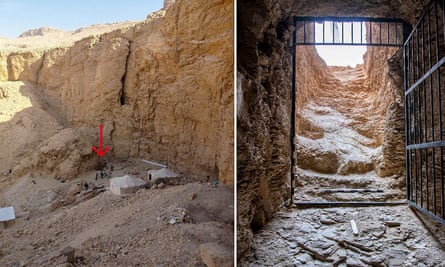It was when British archaeologist Dr Piers Litherland saw that the ceiling of the burial chamber was painted blue with yellow stars that he realised he had just discovered the first tomb of an Egyptian pharaoh to be found in more than a century.
Litherland had been exploring the Valley of the Kings in Egypt for more than a decade when he discovered a staircase that led to the tomb, now known to have belonged to Thutmose II, who reigned from 1493 to 1479BC.
It took months to clear flood debris from the descending corridor and during this time, he and his team assumed the tomb belonged to a royal wife.

But as soon as he saw the ceiling of the burial chamber had been decorated with scenes from the Amduat, a religious text reserved for kings, he knew he had made what has since been hailed as the most significant discovery since Tutankhamun.
He felt an “extraordinary sort of bewilderment” at that moment, he told the BBC World Service. “When I came out, my wife was waiting outside and the only thing I could do was burst into tears.”
He then set about clearing the flood debris, expecting to find the crushed remains of a burial underneath it.
“In fact, the tomb turned out to be completely empty, not because it had been robbed, but because it had been deliberately emptied. We then worked out that the tomb had been flooded. It had been built underneath a waterfall, and it had filled with water at some stage within about six years of the burial.”
The remains of the king were taken out through a subsidiary corridor and moved somewhere else, he said. “It was only gradually, as we sifted through all the material – tons and tons of broken limestone – that we discovered these small fragments of alabaster, which named Thutmose II.”
The fragments were probably broken when the tomb was moved, he said. “And thank goodness they did actually break one or two things, because that’s how we found out whose tomb it was.”
The discovery was made by a joint mission formed by the New Kingdom Research Foundation, a British independent academic foundation, and the Egyptian Ministry of Tourism and Antiquities, a project affiliated with the McDonald Institute for Archaeological Research at the University of Cambridge.
Thutmose II was the husband as well as the half-brother of Hatshepsut, one of Egypt’s greatest pharaohs and one of the few women to rule in her own right, and the father of Thutmose III.
Litherland told PA media: “This discovery solves a great mystery of ancient Egypt: the location of the tombs of the early 18th dynasty kings. The tomb of this ancestor of Tutankhamun had never been found because it was always thought to be at the other end of the mountain near the Valley of the Kings.”
Considering the evidence the contents of the tomb were moved to a second tomb, Mohsen Kamel, assistant field director, said: “The possible existence of a second, and most likely intact, tomb of Thutmose II is an astonishing possibility.”
Source: theguardian.com


















